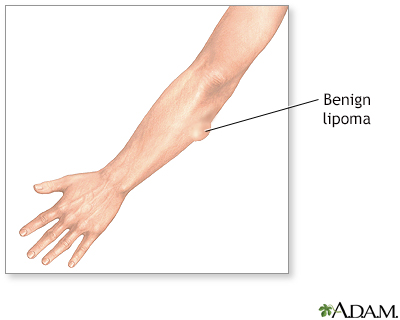Pregnancy SmartSiteTM
DefinitionSkin lumps are any abnormal bumps or swellings on or under the skin. ConsiderationsMost lumps and swellings are benign (not cancerous) and are harmless, especially the kind that feel soft and roll easily under the fingers (such as lipomas and cysts). A lump or swelling that appears suddenly (over 24 to 48 hours) and is painful is usually caused by an injury or an infection. CausesCommon causes of skin lumps include:
Home CareSkin lumps from an injury can be treated with rest, ice, compression, and elevation. Most other lumps should be looked at by your health care provider before you try any home treatments. When to Contact a Medical ProfessionalCall your provider if you have an unexplained lump or swelling. What to Expect at Your Office VisitYour provider will perform a physical exam and ask about your symptoms, including:
Your provider may prescribe antibiotics if you have an infection. If cancer is suspected or the provider cannot make a diagnosis by looking at the lump, a biopsy or an imaging test may be done. ReferencesJames WD, Elston DM, Treat JR, Rosenbach MA, Neuhaus IM. Dermal and subcutaneous tumors. In: James WD, Elston DM, Treat JR, Rosenbach MA, Neuhaus IM, eds. Andrews' Diseases of the Skin: Clinical Dermatology. 13th ed. Philadelphia, PA: Elsevier; 2020:chap 28. Seller RH, Symons AB. Skin problems. In: Seller RH, Symons AB, eds. Differential Diagnosis of Common Complaints. 7th ed. Philadelphia, PA: Elsevier; 2018:chap 29. | |
| |
Review Date: 6/7/2023 Reviewed By: Elika Hoss, MD, Assistant Professor of Dermatology, Mayo Clinic, Scottsdale, AZ. Also reviewed by David C. Dugdale, MD, Medical Director, Brenda Conaway, Editorial Director, and the A.D.A.M. Editorial team. The information provided herein should not be used during any medical emergency or for the diagnosis or treatment of any medical condition. A licensed medical professional should be consulted for diagnosis and treatment of any and all medical conditions. Links to other sites are provided for information only -- they do not constitute endorsements of those other sites. No warranty of any kind, either expressed or implied, is made as to the accuracy, reliability, timeliness, or correctness of any translations made by a third-party service of the information provided herein into any other language. © 1997- A.D.A.M., a business unit of Ebix, Inc. Any duplication or distribution of the information contained herein is strictly prohibited. | |

 Warts, multiple - ...
Warts, multiple - ... Lipoma - arm
Lipoma - arm Warts - flat on th...
Warts - flat on th... Wart (verruca) wit...
Wart (verruca) wit... Skin lumps
Skin lumps
